#to add: i honestly think the constraints of the medium are part of why i bounced from Doctor Who years ago
Text
dissecting companion exits: a doctor who rant in the year 2024
So it's been over a month since I did that Doctor Who podcast, which has miraculously got me back on my Doctor Who bullshit, and after "The Giggle", I've been thinking a lot about companion exits, and how they worked for me and how they worked both inside and out of the narrative. And because what else is social media for than ranting about fiction, here I am.
I find it really interesting how in both Moffat and RTD Who, many of the exits work more successfully outside of the narrative than inside of it, yet for completely different reasons.
Like, "The Giggle" really emphasised how ridiculously tragic the Moffat companion exits were. And while I can't speak for Bill as I haven't watched her series, for both Amy and Clara, those exits didn't make much sense inside the narrative. Amy and Clara could have had non-tragic exits. Amy's run in particular seemed to be working towards her and Rory choosing to stop travelling with the Doctor. They weren't doing it full time, they were getting older (it was highlighted how Amy needed reading glasses now), and it would have made solid character and thematic sense to have them choose to end this chapter in their lives. To focus on their careers, and maybe have kids, and find the joy in the slow path. A slow wind down--a bittersweet yet poignant departure--would not have been untoward.
Clara could have left that way too. She could have either walked off into the sunset with Danny Pink (if he hadn't been killed off. Because he was killed off, right?) or found some other calling. Embracing teaching at Coal Hill. Teaching on another planet. Anything! But I think in both cases, Moffat wanted his "Doomsday", and so what made logical narrative sense took a backseat. These exits worked more outside of the story--"because the showrunner wanted tragedy"--than inside.
Donna, I think, could have also had a non-tragic exit. I know her tragic ending has been reversed, but if Donna had two series instead of one, I think an ending where she chose to leave the Doctor would have been possible. I mean, she loved travelling, but it's clear that she also wanted to do things like get married and have a family, and I think if she had one more series (or was in all four specials), she could have had a Jo Grant exit. But they couldn't get Catherine Tate for another series/all four specials, and RTD was set on leaving before Series 5, so Donna doesn't.
And the constraints of TV filmmaking are what I believe hampered the RTD companion exits. And there are two major ones: actor availability and the time the BBC allowed him to tell his stories.
Granted, while having two tragic exits that weigh on the Tenth Doctor and contribute to him going all "Time Lord Victorious" could have been the plan all along, assuming it wasn't, both Donna and Rose's exits make the most sense when read from an outside perspective: neither Catherine Tate or Billie Piper had signed on for more full episodes.
Rose's second exit, in particular, is the poster child for "outside the narrative" storytelling. I mean, when the Doctor says "But you've got to [stay in the parallel universe]", you nearly expect him to end that with "because your actress didn't sign on for more episodes". Outside the narrative, leaving Rose with TenToo wraps up the Doctor/Rose romance, keeps them mostly safe from the whims of future showrunners, and yet leaves Rose's story a little open-ended for the audience so they imagine whatever they want to happen in Rose's--and future Doctor's--future. Inside the narrative, however, I didn't find it particularly satisfying. The Doctor has been pining for Rose for two series. Rose has worked incredibly had to get back to him. As a character, she's crafted as someone who would stay with the Doctor forever. They have this sweeping, incredibly romantic reunion! Inside the narrative, her staying makes the most sense. It's the most satisfying ending. Especially if you don't have the space to make an ending with Rose's permanent exit gratifying.
Because like Donna and the bigeneration in "The Giggle", Rose ending up back in the parallel world could have been more satisfying if RTD had more time to build up to that exit. In general, much of "Journey's End" feels rushed, and the end of the episode is particularly bad, leaving a number of holes that never get filled. Mickey gives a very brief reason why he's staying in his home universe, but we don't see him say goodbye to Rose and Jackie. We never get a proper reunion between Rose and Jack, or resolution to Rose making Jack immortal, which she is clearly unaware of, nor do we get a goodbye between them. I remember wondering when "Journey's End" first aired, do Mickey and Jack even know that they won't see Rose again? Do they walk off with a quick "see ya later", thinking they'll meet up occasionally? Because Rose sure as hell didn't think she was leaving her home universe. And while we got TenToo on his own to establish that he is (mostly) the Doctor, we don't get much between him and Rose prior to being left on Bad Wolf Bay to build any kind of connection between them. We don't see Ten come to the decision to leave the two of them; we never really know how he feels about it. Yeah, Doctor Who is a very plot-forward show, but "Journey's End" was juggling a lot of plot and a lot of characters, and it should have been longer--or the Series 4 finale should have been a three-parter--to give both the story and characters time to breathe. The audience is left to infer A LOT, and for me it was unsatisfying at the time, and now with over a decade of distance, it's actually even more unsatisfying.
While it might seem like I have more of a problem with RTD's companion exits, I think they're more successful from a technical and audience standpoint than Moffat's. RTD has the incredible ability to write backwards, making you feel like an ending was always something that he was working towards, even when he wasn't. Although both Donna and Rose's stories could have been different given more time, and if they played out in a different medium like a novel, they still, mostly, work. Donna forgets, but gets a family and a mother who values her a little more. Rose gets both the Doctor and her parents--she doesn't have to sacrifice one for the other anymore. Moffat's, on the other hand, feel very slapdash, and I don't recall feeling like we'd been working towards them. Because, as I said, it always seemed like he was working towards a totally different ending.
I'm not entirely sure where I'm going with this, but I find the difference between Moffat and RTD's approach to companion exits really fascinating. One wanted a specific style of ending, but didn't seem to know how to foreshadow it--how to make it work as part of a cohesive narrative. The other had a strong handle on narrative and character arcs, but their ability to craft something satisfying--to give his audience all the information--was hindered by episode length. Going forward, I hope RTD can manage his time better so that the companion exit is more satisfying, like Martha's. But I also hope he takes a leaf out of Moffat's book and plans a non-tragic ending. Because Moffat did set up two fairly sold, amicable partings, and Doctor Who needs more of those again.
#my writing#writeblr#Doctor Who#Russell T Davies#Steven Moffat#criticism#analysis#companions#companion exits#a giant Doctor Who rant?#in 2024?#quel suprise!#this is long and rambly but i needed to get it out of my brain#to add: i honestly think the constraints of the medium are part of why i bounced from Doctor Who years ago#while it's true that Moffat's writing wore me down#the fact that the story i was most invested in--the Doctor and Rose--didn't get an ending i found satisfying was part of it#and that was due to the TV format#and how Doctor Who is a show that continues with the same protagonist#with Doctor Who#you can get satisfying arcs but not really a satisfying story#and that wears on you#i think it says something that the stories i gravitate towards more recently aren't part of franchises#sure i do love Doctor Who and Star Trek#but i think my brain likes concrete endings to stories#i like a completed whole that i can imagine around#and while you can get that with companions on Doctor Who#you can't get that for the show itself#for the Doctor#the fact that even Doctor Who has got so backward looking doesn't help#it's leaving very little for me to imagine
9 notes
·
View notes
Text
book-and-show
My preferred mix of the two canons is basically ‘The Untamed, but Wei Wuxian lost control of his zombies by his own goddamned self, and also plot/logic holes are taped over by explanations from the book when needed and possible. And we know that wangxian are together and will be married, but we're left with spaces to fill in the details.’ (One of the cool/interesting things about having multiple versions of a canon is that one can mix and match!) But there are definitely things that I prefer, separately, about each.
[two very long lists. all of which are all about personal opinions/preferences, and none of which are looking to start discourse!]
Eight Things I liked better about the show:
1. "Who am I to you?" "I had thought, that you were the one who knew me for my whole life." "Still, I am." is *twenty zillion times* more romantic than a stolen blindfold kiss, in a way that pretty much encapsulates why I so much prefer show to novel wangxian overall. And in this TED talk - I mean, in another post, hopefully, in not too long, I will.
2. Lan Wangji's explicit questioning of and overturning his understanding of 'what is right, and what is wrong,' rather than simply being motivated by 'if loving Wei Wuxian is wrong, then screw everything else.'
3. Introducing so very many characters earlier in the chronological timeline, and showing us more about them and their relationships prior to Wei Wuxian's death - and outside of the key moments in which they're involved in the plot. Wen Qing and Wen Ning, Jiang Yanli, Mianmian, Songxiao, Xue Yang, Meng Yao - this list could also be its own post.
4. More focus on the Sunshot Campaign and its aftermath, pre-death, specifically on the period when Wei Wuxian is the feared necromancer, and he and his loved ones are dealing with that, against a background of war and then possibly more war. It's by far my favorite part of the narrative, just because of my preferences re: genres, so I appreciate it being foregrounded rather than just a backstory that's shown in flashbacks.
5. The successive confrontations between Wei Wuxian and Lan Wangji over 'leaving the right path'! In the courtyard, when Lan Wangji pulls Bichen on Wei Wuxian to make him listen; in the sad umbrella rain, when Wei Wuxian holds Chenqing out in front of him, defying Lan Wangji's efforts to rein him in. These things probably fall under the umbrella of the TED talk from the first point, but they're the beating heart of WHY I LOVE THIS STORY. And they're not even in the novel...! I thank the CQL team for my life.
6. Also, THE COMB STORY. I'd never have thought either that 'how do we improve an m/m romance novel? By adding a het romance subplot, of course,' but the fact is that I love the dimension it adds to both Jiang Cheng's and Wen Qing's stories. Highlighting their shared loyalty to their clans - except not shared, because they're from different clans! - but their shared *understanding* of what righteousness, justice, etc., is, and the way it leads to their tragedies, and the way it's a counterpoint to Wei Wuxian's and Lan Wangji's different and ultimately shared understanding of 'what is right' and the way *that* brings *them* together is just... so good. I am getting over it approximately never, and, again, it's show-original.
7. And I think the last big thing - other than, the acting's wonderful, imo, the visuals are great, (even the 'bad' special effects? I like 'em kinda ridiculous?), and when the prose-in-translation of all versions is iffy at best, (not judging MXTX's prose! or the scriptwriters'! but I unfortunately cannot read or understand it) it's REALLY NICE to have other major dimensions of the story that aren't lost or diminished in translation. Honestly, I am only watching cdramas and not reading cnovels (I only read MDZS so I'd know what's in it) for that reason alone. But in terms of *story* stuff -
8. I think that censoring wangxian's relationship down to the '(really really loud) subtext' level counterintuitively also makes the rest of the story seem considerably gayer. If wangxian exists in hints and looks and narrative parallels etc., then likewise, so do the 3zun and Yi City triangles. Not as much as wangxian, but they're more minor characters, and they're on the same continuum... to the extent that I legit thought that songxiao and xiyao would also be novel canon. (They are not.) If Wei Wuxian shocking Lan Wangji by showing him gay porn in the library, and commenting on Lan Wangji's beauty, is because he is actually into guys, then maybe Nie Huaisang lending Wei Wuxian that same porn, and also commenting on Lan Wangji's beauty, means the same thing, if that's all we have to go on. etc.
Nine Things I liked better about the book:
1. There's something about Wei Wuxian's narrative voice, the running commentary that he gives about others and most of all himself that is... funny? Yes, it is, but that's not the part I love. It's hard to pin down, but the pattern of the things he judges and the things he doesn't judge at all, even though maybe he should, but he really has so much empathy - in the literal sense, I mean, as well as the magical - is very specific and endearing? He's exactly like that in the show, too, but we hear much less of it when he's not telling the story.
2. Getting to hear A-Qing in her Empathy fleshes out her cleverness and her bravery, again, in a way that's not easy to replicate seeing it from outside of her head. (I think we may have more of all of the ducklings/juniors, actually, but I'm just not all that interested in their friendly banter. Not when there's life-rending trauma in the OG of the same story!)
3. From the chronological start of the story, the Wens' domination and power-hunger is portrayed in a realpolitik way that's both more interesting and fits the rest of the story better, with the Jins later filling that same vacuum, and fearing Wei Wuxian's potential to do the same sort of thing to them, etc., as chronologically following and competing different takes on the struggle for power, without any need for the flat fantasy mcguffins of the Yin Iron or the 'spirit snatch.'
4. Wei Wuxian ~appreciating~ Nie Mingjue's dead body parts is hliarious. I love him hanging out with the corpse girls. I love the Wens risingout of the blood pool for him ;___;. Overall his relationship withthe corpses that he magics is such a cool weird fun part of the book,that is missing in the show except his friendship with Wen Ning for'let's make a show about necromancy but pretend it's not' reasons.
5. The fact that Wangxian don't split up and go their own ways at the end of the story, even temporarily! I could go either way on 'Lan Wangji becomes Chief Cultivator' - I like the way that it moves into 'the future will be better than the past, and we'll work to make it that way', in the same way that 'the kids are alright' does, and the fact that Lan Wangji hates diplomacy and is bad at it can make for good amusing stories! But I also approve of the fact that the personal win condition for so very many of these characters is to peace right the fuck out of sect politics, (like Mianmian our true hero does <3), and I believe in that as a happy ending.
6. Wei Wuxian's and Lan Wangji's complementary ~ravishment~ kinks. I don't like the exact way they're written in the novel (and extras), but I *will* take and run with the existence of them, nevertheless.
7. The post-resurrection plot makes, um, sense? Let's not forget the importance of that! (But, honestly, 'must a plot make sense'? It's not all that important to me, lol.) Going from one place to another to collect the pieces of 'our dead friend's' body rather than seemingly at random makes the journey feel purposeful rather than direction-less, and gives an indication of progress that's not simply 'amount of the story read as per chapter count.' Though it's still not clear to me why the juniors squad needs to be in Yi City!
8. It has more of Wei Wuxian's inventiveness. Whether founding the Diabolic Path rather than 'just' inventing some tools and talismans within and also outside of it, or figuring out/explaining how some sort of magic works, whether lecturing to the juniors or working it out for himself, or something like that one night-hunting extra where he's being a supernatural consulting detective... it's fun to see more of his ~mind at work,~ in a way that doesn't fit as well either into an audiovisual medium or under the constraints of 'what is happening? definitely not corpse magic!' that censorship imposes.
9. The structure of revealing what happened in (what I can't help thinking of as) the main portion of the plot - who Wei Wuxian is, what his life story is, and Lan Wangji's part in it - through interleaved and not even necessarily in-order flashbacks is... so interesting? Unfortunately I can't tell how well it would've worked for me in terms of changing my understandings of characters etc., because I watched the show before I read the book, so I came to it knowing the outlines of the story. But it's a cool idea, and I wish that I could experience it properly! (Though I would never have read the book without watching the show first, I would've failed out at the start due to translation issues and then if I'd persisted past that due to all the gay chicken stuff.)
#the untamed#this is sufficiently show-slanted#i believe#that i'm not gonna put it in any of the other tags....
14 notes
·
View notes
Text
Game Art Open Project - Task 1 Research
Storytelling is a vast and interesting which can be influenced and enhanced by the medium being used to convey it. At the same time, these mediums themselves can also implement constraints on the story and as such the writers need to be aware of how to navigate these obstacles so that the story can be told in the best manner possible.
For my dissertation I am researching the Seven Story Archetypes and how they can be used to by narrative designers to create stories intended for video games. To take this a step further I also want to implement Jenkins’ Narrative Theory, namely that of evoked narrative types. Evoked narratives are storylines where the video game’s world is “reproduced from another work of fiction” (McEnerney, 2017, p.3). This type of narrative “can paint their worlds in fairly broad outlines and count on the player/visitor to do the rest” (Jenkins, 2002, p. 6/123), it relies on the familiarity or prior knowledge of the player to help the story. As such, I will be using a premade franchise and the Archetypes to create my own story, I will use transmediation and remediation to make it possible for my written story to conveyed through a video game.
Transmedia is the act of “weaving stories across multiple platforms and expanding learning and engagement” (Rodrigues & Bidarra, 2014, p.42/1). Transmedia is interwoven with the concept of my dissertation subject because it can be directly linked to creating multiple storylines from a single franchise. Narrative designers must constantly consider how to create these expansive and interesting narratives while keeping in mind the original storyline and world. Which is why it can be linked to my dissertation subject and in turn this project, due to how my dissertation will involve creating an evoked narrative from an already established franchise. Another concept to be considered is that of remediation, as the act of “borrowing or repurposing can take not only the content from an earlier medium, but also incorporate and refashion” (Dobson, 2006, p.4). This can also be linked to Jenkins’ evoked narrative and be incorporated into the heart of both my dissertation concept and the Game Art Open Project. The reason being that since I am going to be creating a new storyline from an already established franchise, then for this project I can create the game visuals depicting these characters in their original style or a different art style that would better fit with the theoretical game.
Since I will be creating a story and then remediating it into a video game for my dissertation, I have researched game types that would best fit my current programming ability and be able to convey my narrative in a fun and interesting manner to the player.
As such, the type of game that would best present my area of study and would be possible to make with my current level of skills is that of Point and Click games. This game’s main mechanic is clicking on specific game objects, doing this allows the player to interact with the game in different ways. There are three different results that can come about from using this mechanics:
· It can bring up information linked to the object
· It can move certain objects from one place to another and
· It can move the main character to that object so that they can interact with it

Point and Click games [ (left to right) Thimbleweed Park, Machinarium & Grim Fandago Remastered]
This game type is made to always display a single scene at a time, at times also allowing the player to slide left to right to reveal more of the area. Though the game can be made with 3D assets it is more often made to be in a 2D art style. Which also resolves another issue, as I do not have that much experience creating 3D models from start to finish it would be more beneficial to create a game in a 2D art style. As I am more comfortable creating 2D game art this is also an opportunity for me to improve on my abilities in this area.
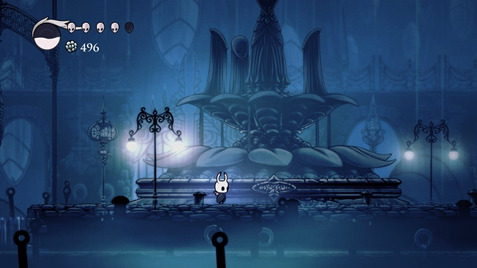
Hollow Knight (2017)
Since the 2D art style is the style I will be using, part of my research has been looking at different ways of drawing 2D art and deciding which to implement in the game. The first art style I am considering is that of the Hollow Knights art style, with a minimalistic character designs but detailed and extensive environmental designs. The pros of using this style is that the characters are minimalistic so I would not need to work too long on them, especially if said characters are only going to have a few poses and no animation. The environmental art style creates a great contrast to this minimalism and would suit a Point and Click game as the main character will not be appearing on screen, except in cutscenes and text conversations. Cons of this style is that the environment is too detailed for the short timeframe that has been allocated to me.

Tales of Vesperia Opening Theme (2019 - Steam)
The second art style I am considering is that of the anime art style, specifically the ones used to mirror anime and manga artwork. The pros of this style are that if done well it can be very beautiful because it adds detail to props, characters and the environment. The con of this is that due to its detail it takes a lot of time, so much so that in actual video games this art style is saved exclusively for cutscene and the chat skits, while the rest of the game is made in a 3D style. So even though it is tempting for time that it would take to do this, even for the game type I would be making, it is too risky for a prototype.

Persona Q2: New Cinema Labyrinth (2018)
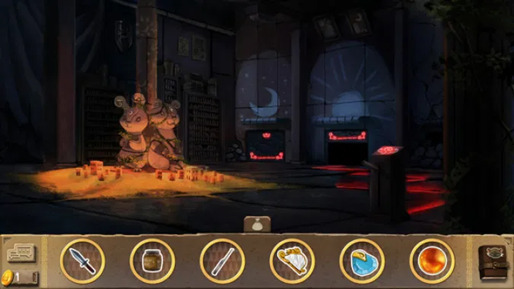
NAIRI: Tower of Shirin (2018) in-game
The other art style I am heavily considering is that found in Persona Q2: New Cinema Labyrinth and NAIRI: Tower of Shirin. The art style of the game is minimalistic in all aspects but not to the point that it eliminates a lot a features. The emphasis of design in this style is the use of exaggeration to emphasis personality and characteristics of the designed characters. As for the environments due to this simplified design there is still a good amount of detail but not so much that it consumes time, instead the draw of this environmental art is the use of good colour balance, lighting and shading. This would fit in with the theme of Click and Point games very well, since these game emphasis more on the environmental art than the character design itself at times.
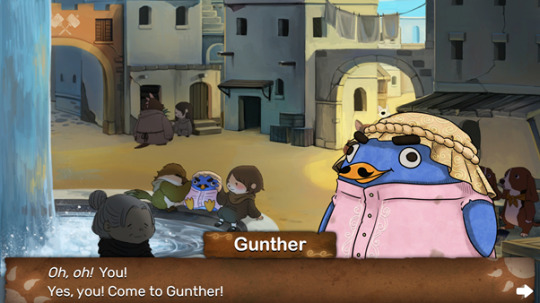
NAIRI: Tower of Shirin (2018) cutscene
Another feature on Click and Point games is the frequent use of cutscenes, that can be used to move the story forward and allow the main character to interact with other side characters. These cutscenes can also be used to display character’s conversing with each other with the use of text bubbles. A method that artists use to make these conversation cutscenes much more interesting and realistic to the player is by create some small character animation. This can be done in two ways, one being that the character has a simple frame-by-frame animation that allows them to move slightly, giving the impression that they are breathing and alive. The other method is to have the characters stay in static poses, then depending on what they are saying change said pose into another.
From playing NAIRI, I find that it leans more on the Interactive Storytelling medium rather than a game. Though the puzzles would push it back into the game side of the spectrum at times it felt a bit too slow and boring. It was honestly my interest in the story that kept me ‘playing’, which I discovered later was more of a teaser/prequel type of story, due to the cliffhanger at what felt at the beginning of the story. From this observation, I would need to make sure that the gameplay engages the player. So, after researching various Point and Click the gameplay mechanics that they make use of is puzzles, action and text choice. Having puzzles engage the users mentally and by having the opportunity to ‘choose’ what they are going to say can make the player feel that the story is a more unique experience and that they have more influence. Another mechanics I would want to enhance in the game is that of action, Point and Click games have this action gameplay present when a player is picking up items, using items and even when they decide where the character is going to go. I have thought though of trying to add dynamic movement to the action gameplay, but in a way that can fit the theme of Point and Click.
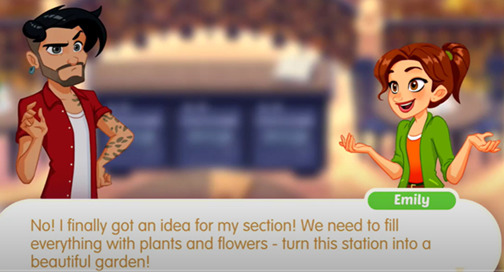
Delicious World (2019) Conversation Cutscene
I found that video games which can fit this dynamic action are those made for the mobile. Since they demand the player to always tap the screen, they have found a way to create scenarios that demand for dynamic action and engagement. Delicious World (2019) is a perfect example of meshing dynamic tap mechanics with storytelling, since the game centres around cooking then the ‘point and click’ gameplay of each level involves the player quickly preparing food and delivering it to the customers under different constraints. The other more mellowed example is that of Harry Potter: Hogwarts Mystery it makes use of timing tap mechanics to keep the players engaged.
Though I would like to implement this I am not sure I would be able to due to the timeline and the lack of scripting knowledge. It is a thought and if I have time and am able I would like to find different means of implementing this in a Point & Click game, for now I will keep the concept as a backburner idea.
The research I presented thus far has shown my dissertation idea, the means and methods needed to create the project and my thought process. For the Game Art Open project I have decided to create parts of the dissertation in this area. As such, I believe that doing all the character art and sound design in the Game Art Project is the best course of action. As I have already delegated the environments to one subject and the narrative design to another I think it is necessary to place and work on a key factor of the project in this subject. The reason I will be working on character art is not only so that I have something visual to present, but also because of the constant change and adjustments needed for character design. Due to having gotten permission from Pirateaba’s Legal Agent I can use The Wandering Inn as the base of my dissertation. This means that the characters created will be my own in a manner including their designs. This makes the process a bit longer but since it is a very short story that ends in a cliffhanger there will not be many characters introduced.
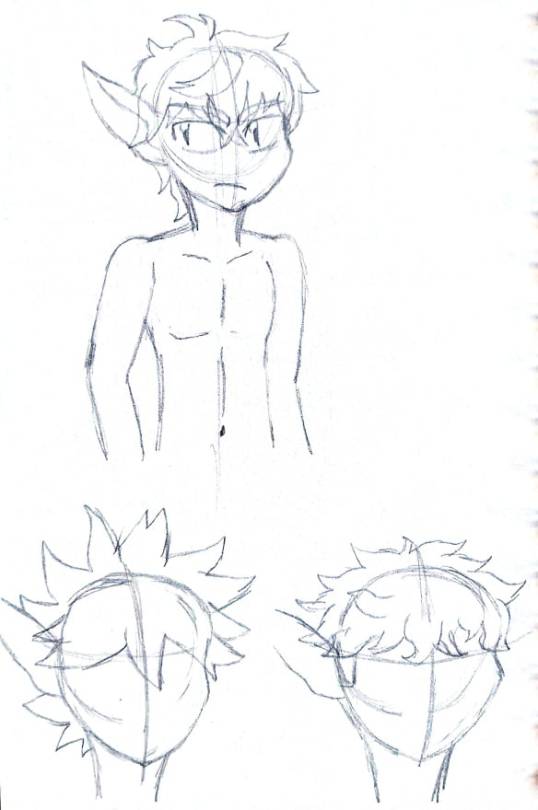
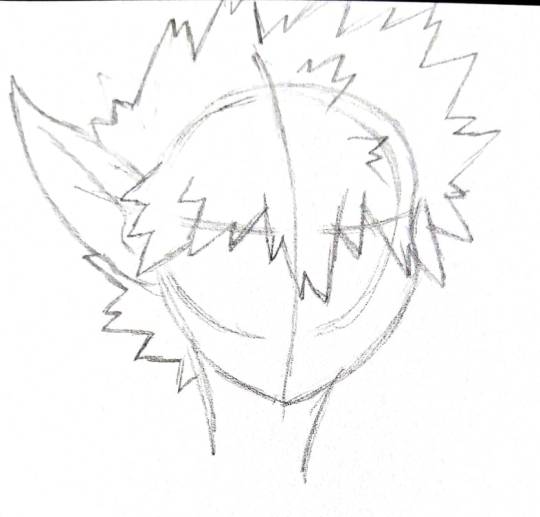
Main Character Sketches
If I have enough time I would like to create cutscene as still image scenes to help convey the narrative better. In these scenes one would see a full-scale character presented so I believe that if I have time to do this it would be better if I have a long period of time and an area where I can dedicate all my concentration to it, instead of having it divided between the other necessary factors. That is also the main reason why I am going to do sound design in the Game Art Open Project.
I have two reasons for doing this, one by implementing sound into the game I can enhance the overall experience. The other reason is that I have not had much chance to be exposed to sound, so I find that this is a good opportunity for me. The sounds I am aiming for are that of background music, a sound to indicate the player has picked up an item and a sound that indicates the player cannot do a certain action. These sounds can better enhance the scenes and make it more interested to the player because more senses are being engaged.
References:
Booker, C., 2006. The Seven Basic Plots: Why We Tell Stories. 1st ed. New York: Continuum.
Campbell, J., 2004. The Hero with a Thousand Faces. 3rd ed. New Jersey: Princeton University Press.
Carvalhais, M. & Cardoso, P., 2018. Narrative games in ergodic media. Estudos em Comunicação, 2(27), pp. 55 - 65.
Green, M. C., Fitzgerald, K. & Moore, M. M., 2019. Archetypes and Narrative Processes. Psychological Inquiry, 30(2), pp. 99 - 102.
Ince, S., 2006. Writing for Video Games: A Scriptwriter's Guide to Interactive Media. 1st ed. London: A & C Black Publishers Limited.
Jenkins, H., 2004. Game Design as Narrative Architecture. In: N. Wardrip-Fruin & P. Harrigan, eds. First Person: New Media as Story, Performance, Game. Cambridge: MIT Press, pp. 118 - 130.
Juul, J., 2002. The Open and the Closed: Games of Emergence and Games of Progression. In: F. Mäyrä, ed. In Computer Games and Digital Cultures Conference Proceedings. Tampere: Tampere University Press, pp. 323-329.
Juul, J., 2003. The Game, the Player, the World: Looking for a Heart of Gameness. In: M. Copier & J. Raessens, eds. Level Up: Digital Games Research Conference Proceedings. Utrecht: Utrecht University, pp. 30-45.
Koenitz, H., 2018. Narrative in Video Games. In: N. Lee, ed. Encyclopedia of Computer Graphics and Games. New York City: Springer International Publishing, pp. 1-9.
Larrimer, S., 2014. Where Storytelling and Interactivity Meet: Designing Game Mechanics that Tell a Story, Ohio: The Ohio State University.
Rodrigues, P. & Bidarra, J., 2014. Transmedia Storytelling and the Creation of a Converging Space of Educational Practices. International Journal of Emerging Technologies in Learning (iJET), 9(6), pp. 42 - 48.
Vanderbeke, D. & Cooke, B., 2019. Evolution and Popular Narrative (Introduction). In: D. Vanderbeke & B. Cooke, eds. Evolution and Popular Narrative. Leiden: Brill / Rodopi, pp. 1-22.
0 notes